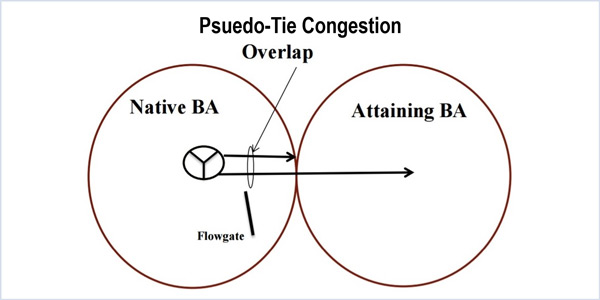By Amanda Durish Cook
MISO’s Independent Market Monitor last week filed a complaint over PJM’s pseudo-tie procedure, the latest volley in an increasingly complex debate over the future of the pseudo-tie concept.
Spurred by a recent PJM bid to tighten its pseudo-tie rules, Monitor David Patton filed a Section 206 complaint April 6, claiming that the increasing use of pseudo-ties degrades reliability, hinders efficient dispatch and raises costs. He asked FERC to eliminate PJM’s existing pseudo-tie definition (EL17-62).
“PJM has asserted that it has a very broad right to impose requirements on external generators to ensure that their capacity can be delivered reliably and efficiently, but the PJM pseudo-tie practices exceed all reasonable bounds,” wrote Patton, whose Potomac Economics firm provides monitoring for MISO and NYISO.
NYISO also took issue with PJM’s March 9 FERC filing seeking approval to apply more stringent requirements on external capacity resources serving the RTO’s load. PJM wants the new rules to be effective in time for its May 10 Base Residual Auction (ER17-1138). (See PJM to Tighten Pseudo-Tie Rules Despite Stakeholder Pushback.)
In a March 31 protest, the ISO said PJM’s proposal — which would allow PJM to commit and dispatch generators directly interconnected to the New York Control Area — “could threaten the reliable operation of the NYCA and disrupt the NYISO-administered markets.”
Patton said PJM provides only “scant support” for its new, “arbitrary parameters,” and that the filing makes it “impossible for any supplier in MISO that does not currently have a unit pseudo-tied to PJM to meet these requirements to offer capacity in the [Reliability Pricing Model] forward auctions.”
If the new rules are implemented, PJM’s customers could experience annual capacity cost increases of $500 million to $4 billion, Patton said. The complaint suggested that FERC consider replacing pseudo-ties with a firm capacity delivery procedure, a collaborative approach that Patton and MISO presented last year. (See PJM Filing Renews MISO Monitor’s Call for Pseudo-Tie Elimination.)
PJM Cries Foul over MISO Pro Forma
Meanwhile, PJM and MISO are attempting to settle a disagreement over the Midwestern RTO’s stricter pseudo-tie pro forma agreement.
The two RTOs are considering adding coordinated pseudo-tie policies to their joint operating agreement “in lieu of MISO being a signatory to PJM’s agreement,” MISO Senior Director of Regional Operations David Zwergel said during an April 6 Reliability Subcommittee meeting.
Zwergel said the discussions are the result of PJM’s March 21 protest of MISO’s pro forma filing (ER17-1061).
“MISO made this filing without the opportunity for PJM to review, leaving PJM no choice but to file this protest and seek revisions to this agreement through the commission,” PJM wrote. It asked FERC to require MISO to “revise any provision of the proposed agreement to the extent it gives MISO unilateral authority to control the implementation, operation, suspension and/or termination of the impacted pseudo-tie, or is inconsistent with the coordinated implementation and operation of pseudo-ties as between MISO and PJM.”
PJM said it sought MISO input on the development of its own pro forma pseudo-tie agreement but was not granted the same courtesy.
Work Continues on Double-Counting Congestion
In a related matter, the two RTOs last week presented an update to their proposal for eliminating overlapping measurements of congestion related to pseudo-ties.
During an April 7 Joint and Common Market Initiative meeting, the RTOs proposed a revised solution that involves exchanging more congestion information in the day-ahead market and refunding or charging pseudo-tie owners for deviations between day-ahead predictions and real-time numbers.
“The RTOs will coordinate pseudo-tie firm flow entitlement impacts before the day-ahead run so that the congestion and the day-ahead LMPs for the pseudo-tie resources will better reflect actual congestion,” the RTOs said.
“We’d be aligning our firm flow entitlement impacts in the day-ahead to reflect what we think the settlement will be in real time,” said Kevin Vannoy, MISO director of forward operations planning.
PJM Interregional Coordination Manager Tim Horger said the solution solves the double-counting issue “as best we can” with prices more reflective of the real-time market. “It’s not going completely solve congestion, but we’re measuring that pseudo-tie impact on every coordinated market-to-market flowgate,” he said.
Horger said that the impacts will be brought “in front” of LMPs and pare down “excess congestion” that is usually folded into the pricing, reducing the need for refunds.
PJM and MISO staff have not yet determined which Tariff or JOA changes might be necessary, but Horger said pseudo-tied resources will not have to make any changes. Vannoy said MISO and PJM hope to adjust the market-to-market settlement process in time for a June 1 implementation.
A future phase of MISO and PJM’s solution will allow for optional scheduling and settlement of pseudo-tie transactions in the native balancing authority’s day-ahead market. In February, MISO and PJM said they would provide congestion rebates in the near term while developing a way to incorporate pseudo-ties in the day-ahead scheduling process by 2018. (See MISO, PJM Propose Solution to Pseudo-Tie Congestion Problem.)






